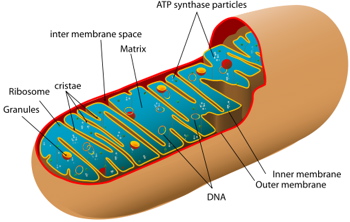Aerobic and Anaerobic Respiration
Online Biology Dictionary

|
| Structure of a mitochondrion. In aerobic respiration, pyruvate is transported into a mitochondrion, where the process of oxidation is completed. |
Respiration is the oxidation of energy-rich storage molecules, primarily glucose, to produce adenosine triphosphate (ATP), a nucleotide with multiple functions. In its phosphate bonds ATP stores energy produced by photosynthesis and respiration. This energy is consumed by various metabolic processes when ATP is hydrolyzed into ADP (adenosine diphosphate).
In aerobic respiration — which occurs in plants, animals, and many prokaryotes — glucose and oxygen are converted to carbon dioxide and water, producing on average 38 ATP molecules per oxidized glucose molecule.
In anaerobic respiration, which occurs during fermentation, less energy is extracted — only two ATP molecules per glucose molecule — because the products of the process, such as ethanol or lactic acid, contain more energy than does carbon dioxide, the product of aerobic respiration.
Both aerobic and anaerobic respiration begin with glycolysis to produce pyruvic acid, but thereafter the pathways differ. In aerobic respiration, the pyruvate is transported into a mitochondrion and metabolized there, whereas in anaerobic respiration it's processed in the cytoplasm.
Respiration pathways are essentially the opposite of photosynthetic pathways, since they produce carbon dioxide and water from oxygen and glucose, while photosynthesis produces oxygen and glucose from carbon dioxide and water.
| Etymology: The word aerobic (pronounced "air-Ō-bick") is derived from the prefixes aero-, (meaning "air") and bi- (meaning "life"), and the suffix -ic (meaning "in the manner of"). Anaerobic (pronounced "AN-ə-RŌ-bick") is constructed by adding the prefix an-, meaning "without." |